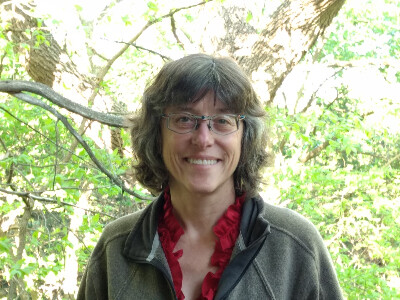AOK BOD Spotlight of the Month: Elizabeth Dodd
How did you get started in AOK?
I was a member of the Flint Hills Audubon Society back in the 1990s and remember the earliest formation of Audubon of Kansas. However, I didn’t really get involved until joining the board in 2020.
What is your background? Have you always lived in Kansas?
I was born in Colorado, grew up in southeast Ohio and came to Kansas in 1989. Until moving here, I had no personal experience with tallgrass prairie. It all seemed too open, too bare! It took years for me to learn how to really see this landscape, and that process meant both learning about the dynamics of prairie plant and animal communities, as well as spending a lot of time outside.
What is your most memorable AOK experience?
While visiting the Hutton Ranch in high summer, we spotted the Sandhill Cranes in their little family group, down in the wet meadow by the river. The birds spotted us, too, of course, though we were surely a quarter mile or more away. The colt and a parent were there, feeding in the open--and then they weren't, having slipped into invisibility in the high grass. A bit later, one head popped up, looking away towards the woods' edge, looking, looking, as if silently calling with just a gaze. Over the span of 20 minutes or so, the family group slowly rejoined one another, and disappeared once again.
What is your greatest conservation concern?
Climate change, already wreaking havoc with higher latitude ecosystems and laying stress on those closer to home, should probably be everyone’s greatest concern. The world, and the US in particular, has squandered decades when we could have been working to help preserve the climate in which all the communities that we love, natural and cultural, evolved and flourished. But there are many other issues that are more locally manageable. Tallgrass prairie is one of the most endangered ecosystems on earth, even more so than old growth forests. I worry that this biome, so long a holdout in Kansas, is vanishing here as elsewhere.
What gets you excited about nature? What is your passion?
I love the cyclical intricacy of the natural world, and the way, after years in a place, you can get to know the “calendar” of phenology—the way the life patterns of species interact with the changing seasons. There’s the joy of learning the details (when, exactly, do the phoebes show up in Riley Country? Just about every year, March 16 or so) and the delight of being outside, soaking in the experience.
What is your favorite spot in Kansas?
Unfortunately, there is very little public land in Kansas—less than most states in the country! Even so, I can’t pick just one spot. This year, I’m especially fond of the trails around Kanopolis. During a visit in January, when there were very few other visitors, I spent a couple of days hiking through the prairie and watching for hawks. In those very short winter days, with the sun low in the sky, all the texture of the landscape seemed to stand out as if the wind had just lifted everything to attention.
How did you connect with nature growing up?
Lots of time outside hiking and camping. The part of Ohio where I grew up was old coal mining country, and even though we enjoyed a great park system and nearby state forests, hiking trails ran through unreclaimed strip mines and some of the streams were practically dead because the water was so acidic. I grew up knowing the world was both beautiful and wounded.
What accomplishments are you most proud of?
I’m especially proud that my family has environmentalists in both hemispheres of the planet! My younger brother, whom I took camping and backpacking when I was in college, became the general manager of a sanctuary in New Zealand, dedicated to the preservation severely threatened birds and other wildlife. So many flightless birds endemic to only New Zealand are now extinct, and the country is trying heroically to save the rest. Meanwhile, here in Kansas, working with AOK I can hope to help prevent both migratory and resident species from disappearing.
